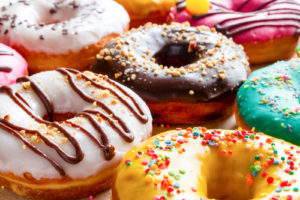Trying to figure out your nutrition for your next long run or race? Austin Bonds from Big Peach Running Co. Suwanee has a few tips!

On February 15th of 2015, Saturday Night Live (1975-present) marked a major milestone: forty years of stellar comedy. What a remarkable accomplishment. Legendary hosts, former and current cast members and renowned musicians gathered together to recount the best sketches in show history. I missed the television special but visited the NBC website in the following days to peruse the collection of videos. Incidentally, sports are always fair game for humor, and the John Belushi “Little Chocolate Donuts” (1977) sketch is a favorite of mine. Belushi portrays a decathlon champion who attributes his athletic success to donuts, noting that “they’ve got the sugar I need to get me going in the morning.” What runner wouldn’t like to employ Krispy Kreme or Dunkin’ Donuts as their exclusive food source for training or racing? I know I would, but like hydration, nutrition is also a complex subject and worthy of a deeper conversation.
Nutrition is vital for running. If you are a newer runner, you will begin to hear this particular word on a more regular basis as time elapses. Questions will eventually be posed of you too. What do you eat on a run? What do you fuel with? What’s your fueling strategy? Speaking of which, “fuel” is a good synonym for nutrition, and this word is the ideal illustration for runners. Picture this in your mind. Gasoline (fuel) is inserted into a car tank to keep an automobile in motion; carbohydrates (fuel) are inserted into the mouth to keep a body in motion. In short, carbohydrates (namely sugar) are the source of energy for runners. They keep energy levels high. That said, when should a fueling strategy, if any, play a more prominent role in your runs? What follows are a few thoughts of note.

1. Utilize mile markers. In other words, consider the distance. If you are only walking, a fueling strategy is unlikely to be necessary. Conversely, let’s say that you are up for completing a 5K race in the near future. Is a fueling strategy needed here? Unlikely – eat a simple breakfast the morning of the race, though. A banana or toast with peanut butter will suffice. Stick with carbohydrates that are digested easily. What of the 10K, half marathon, and mighty marathon though? To finish these distances, you will need to run more regularly, and these runs will begin to exceed sixty minutes in duration as the weeks unfold in preparation for the race.
2. Utilize trial and error. Runs exceeding sixty minutes require extra energy via fuel (carbohydrates). The next time you visit your local Big Peach, have a look at the Long Run Ready wall. Fuel products are stacked from floor to ceiling as gels, chews, bars, and powders all clamor for your attention. So – which is the right product to use? I suggest starting with a gel. They can be eaten quickly and are available in numerous flavors to accommodate taste preferences.
Having completed numerous races myself, I find that one gel per hour usually provides adequate fuel; however, the intensity (i.e. pace) and distance of a training run or race may require the need for extra fuel. Also, if a gel bothers your tummy, try a chew (Honey Stinger) or bar (Bonk Breaker) or powder (Generation UCAN, Skratch, or Tailwind). Ask a Big Peach Guest Advocate for advice too, but take ownership of your product mix and use it regularly.
3. Utilize consistency. After finding a good fuel source, use it consistently so the body responds well. This consistency will prove to be wise on race day too. Bring the fuel you train with on race day or be sure to train with the provided fuel on the course to steer clear of stomach issues by introducing an untested product. Furthermore, consume the fuel with water – not Gatorade or Powerade. Gatorade or Powerade with a gel constitutes too many carbohydrates, and this influx of sugar can create a cramp.
In summary, distance, pace, the right product, and consistency are the four components of a strong fueling strategy, though much more can be said on the subject, e.g. carb loading, fat burning, gluten free products, and what type of carbohydrate is best. Like hydration, nutrition appears daunting at first, but there are a wealth of resources available on the subject, along with experts at Big Peach Running Co. who are eager to impart their knowledge and answer every question you pose regarding fuel, be it a Clif gel, Power Bar chew, or Little Chocolate Donuts.
Speaking of doughnuts, should you wish to follow in the footsteps of the great athlete John Belushi and fuel your runs with fried dough, numerous doughnut races are available today in the United States. For instance, consider Raleigh, North Carolina, and the Krispy Kreme Challenge. Here is the task. Run 2.5 miles to a Krispy Kreme store; eat one dozen doughnuts; and then run 2.5 miles back to the start. By the way, the time limit for this race is sixty minutes. One dozen original glazed doughnuts are undoubtedly adequate fuel for that return trip, though keeping them in your stomach is another story. Let’s just say that digestion follows nutrition.
Austin Bonds is a Guest Advocate at the Big Peach Suwanee location.


